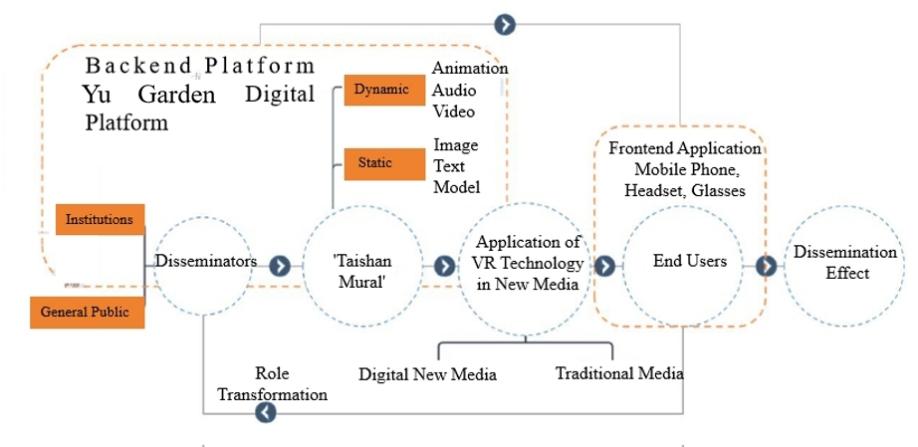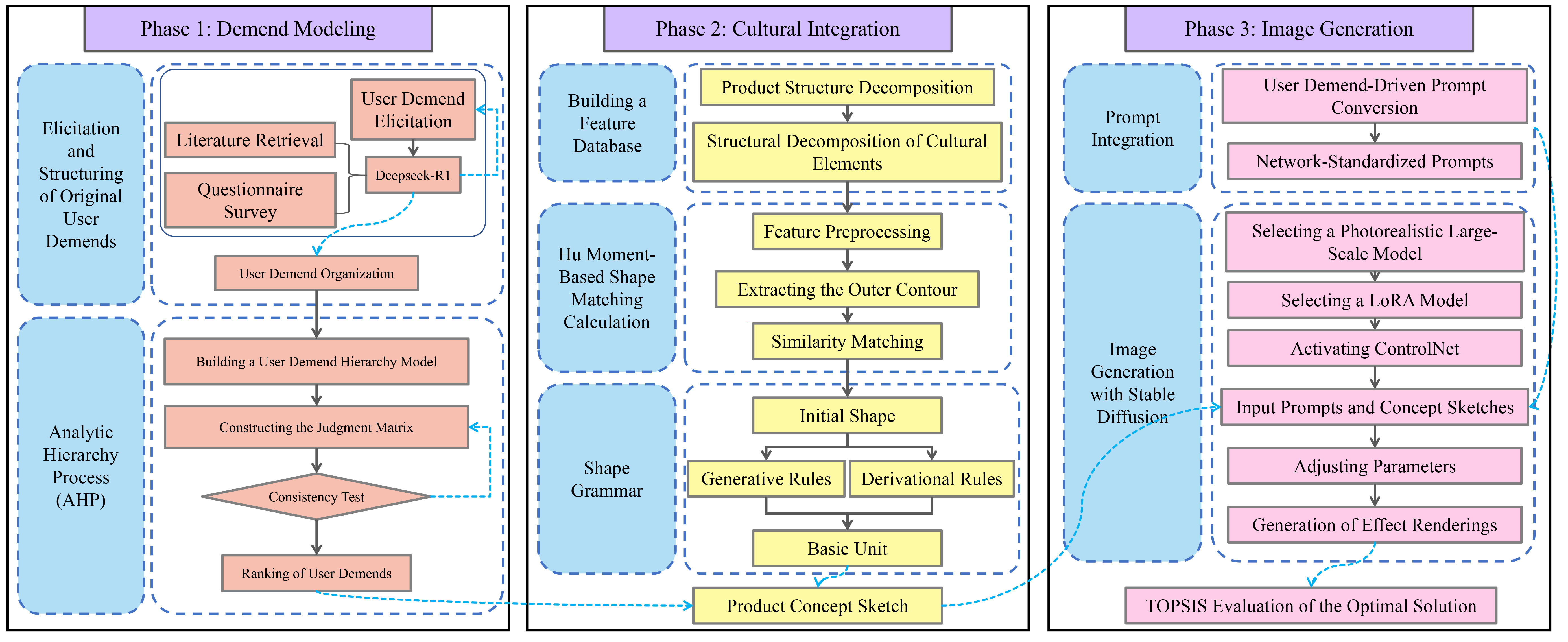Volume 73
Published on September 2025Volume title: Proceedings of the 4th International Conference on Art, Design and Social Sciences
The development of metaverse technologies offers a new paradigm for the value reconstruction of rural cultural tourism industries. Focusing on the Hani Rice Terraces in Yunnan as a case study, this paper, grounded in digital narrative theory and industrial value chain theory, constructs a three-layered artistic narrative framework—“symbolic translation – interactive immersion – philosophical resonance.” This framework systematically explains how rural cultural resources can be artistically reinterpreted within metaverse spaces to facilitate the transformation from cultural value to economic value. Through policy text analysis, cross-case comparison, and theoretical deduction, the study reveals the internal mechanisms by which artistic narratives drive innovation in cultural tourism products, promote industrial synergy, and restructure benefit distribution systems. Furthermore, it proposes a “lightweight technology + localized narrative” management strategy tailored to rural contexts, offering both a theoretical framework and practical guidance for the digital transformation of rural cultural tourism.

 View pdf
View pdf


Reduplication, as one of the morphological construction methods in Modern Chinese, serves as a crucial grammatical device. The Yongdeng dialect, part of the Lanzhou sub-group of the Central Plains Mandarin (Lanyin Mandarin), exhibits a rich array of reduplicated adjective forms. This paper investigates the reduplication of adjectives in the Yongdeng dialect from three perspectives: structural patterns, grammatical meanings, and pragmatic functions. Based on whether the reduplication is complete or partial, six main types are identified and discussed: “AA,” “AABB,” “ABAB,” “ABB,” “AACD,” and “ABCC.” The study analyzes their grammatical roles in expressing degree and state, and explores how these reduplicated forms enhance vividness and imagery in pragmatic usage.

 View pdf
View pdf


This study carries out a systematic analysis on the process of evolution of geopolitical rivalry and diplomatic strategies between China and Australia during the 3rd stage of economic globalization. The study finds that China-Australia relations have evolved into a complex landscape characterised by a transition from economic complementarity to a coexistence of strategic competition and cooperation. Australia's relations with China are shaped by three main aspects: multilevel strategic concerns about China's rise, structural constraints due to the Australia-US alliance; and home-grown political forces shaping its relations with China. From the research, it is observed that new changes in economic globalization 3.0 like reorganization of global value chain, and growth of digital economy are having an immense impact on the interaction pattern between China and Australia. This article proposed policy suggestions on how to advance healthy Sino- Australian relations from three parts,which are strategic communication between China and Australia, Economic and Trade cooperation, People-to-People relationships. Also put forward some future research areas, like digital economy cooperation and economic and trade cooperation under RCEP framework etc. According to this study, it seems that if China and Australia can properly deal with their differences and innovate how they cooperate, they will be able to establish a more stable and mature bilateral relationship.

 View pdf
View pdf


This paper investigates the systemic stigmatization of female performers in 19th-century Qing China and Hungary through a cross-cultural comparative framework. In both societies, women engaged in theatrical professions—though vital to artistic innovation—faced institutionalized marginalization. In 19th-century China, female opera performers faced explicit prohibition from public stage performances under Qing state decrees. They endured dual marginalization through institutional and social mechanisms: legally categorized as "degraded status groups" within the household registration system, their status was formally degraded below that of ordinary women. Simultaneously, pervasive social stigmatization conflated them with prostitutes in public discourse, regardless of actual professional distinctions. Concurrently in Hungary, actresses and ballet dancers, and other low-status theatre workers were publicly equated with courtesans or even sex workers; their professional dedication was obscured by societal fixation on their perceived moral transgressions. These parallel patterns demonstrate how patriarchal power structures exploited gendered stereotypes to suppress women’s vocational agency. By conflating artistic labor with sexual misconduct, authorities in 19th-century Qing China and Hungary reinforced rigid gender hierarchies that confined women primarily to domestic spheres as wives and mothers, effectively excluding them from public creative expression.

 View pdf
View pdf



Chinese excellent traditional culture is the root and soul of the nation and an important embodiment of the soft power of Chinese culture. VR technology has gradually become an important means of cultural heritage (HLA) education because of its immersion and interactivity. In recent years, the Ministry of education has promoted the VR application in education to break through the limitations of time and space, which provides students with a more vivid and interactive cultural experience. The purpose of this study is to design and develop a HLA display system based on VR technology. Taking "Yu Garden" as a research case, this study explores the realization of digital display and interactive communication of HLA through VR technology, and provides students with immersive historical and cultural experience through the development of VR system. In the cultural heritage digital display (CHDD) system , the design of host and client virtual user role (UR) is the core of information interaction. This paper designs the interaction mechanism between the host and client by defining the interaction coefficient, information accumulation and other parameters of the host virtual UR. The experimental data show that the "Yu Garden" display model based on VR technology provides users with an immersive cultural experience, and the combination of audio and video makes the history and culture of murals more vivid.

 View pdf
View pdf


This paper explores the value orientation of Chinese folk songs in the intangible cultural heritage protection system, as well as the practical exploration of their protection and inheritance. The study points out that folk songs, as carriers of cultural inheritance, artistic aesthetics, social cohesion, educational enlightenment, and economic resources, possess multi-dimensional values. Facing challenges such as the impact of modernization, lack of inheritors, crisis of cultural identity, limited communication channels, and inadequacies in the education system, effective strategies for the protection and inheritance of Chinese folk songs are proposed through practical approaches including policy support, digital protection, integration into education, community participation, and innovative development, promoting their vitality in modern society.

 View pdf
View pdf



Artificial intelligence (AI) and human–robot interaction (HRI) are moving from controlled labs to complex public environments. Outdoor cultural tourism events (e.g., music festivals) face recurring pain points in waste management: rapid waste generation, slow manual response, and low visitor engagement with sustainability. This paper reports on the UX-centred design and field evaluation of an intelligent waste-sorting robot tailored for temporary outdoor cultural venues. The system integrates computer vision–based recognition, LiDAR navigation, robotic grasping, and real‑time information visualisation with user research, co-design, and iterative prototyping. A mixed‑methods study (surveys, interviews, observations) with organisers, regulators, and visitors informed the interaction model and service blueprint. In a festival pilot, the prototype doubled collection efficiency relative to manual practice, achieved over 90% recognition accuracy, and reduced unattended litter by 27%, while visitors reported higher sustainability awareness. Contributions include: (1) a UX‑centred HRI framework for public cultural spaces; (2) a design pattern catalogue for legible, low‑friction interactions in crowds; and (3) empirical insights into transparency, trust, and acceptance relevant to deployment and policy in smart‑tourism contexts.

 View pdf
View pdf



To address the difficulty that generative artificial intelligence (AIGC) faces in deeply and innovatively integrating cultural elements with product carriers in cultural-creative product design, this paper proposes a “demand-modeling — cultural-integration — scheme-generation” design method for cultural-creative products. In the demand-modeling stage, Deepseek-R1 is combined with the Analytic Hierarchy Process (AHP) to precisely identify user needs; in the cultural-integration stage, the concept of Hu moments (invariant moments) and shape grammar are introduced and combined with user requirements to achieve a structured fusion of cultural symbols and product form; in the scheme-generation stage, design proposals are generated using Stable Diffusion (SD) and the Technique for Order Preference by Similarity to Ideal Solution (TOPSIS) is employed to evaluate and select the optimal proposal. A Ming-style hoop-back chair is used as the carrier and Sanxingdui bronze motifs as the cultural elements in a case study. The proposed method is able to achieve deep integration of cultural elements with products while satisfying user needs, effectively bridging the gap between technical rationality and cultural sensibility, and provides new ideas and methods for cultural-creative product design in the artificial intelligence era.

 View pdf
View pdf


Based on the growing demand for OTC drugs among the elderly under the background of China’s accelerating aging population, this study focuses on the problems in pharmaceutical packaging design, such as poor readability, operational difficulties, and weak auxiliary identification. By introducing the concept of inclusive design, and starting from the multidimensional characteristics of the elderly in terms of physiology, cognition, and socialization ability, a design strategy framework is proposed, centered on cognitive inclusion, functional inclusion, and emotional inclusion. Through specific approaches such as information hierarchy optimization, multi-sensory synergy, and linking to social resources, this study systematically constructs design methods that improve the usability, comprehensibility, and emotional identification of drug packaging. The aim is to provide the elderly with a safer, more autonomous, and dignified medication experience, while also offering theoretical references and practical guidance for pharmaceutical enterprises and design practices.

 View pdf
View pdf



